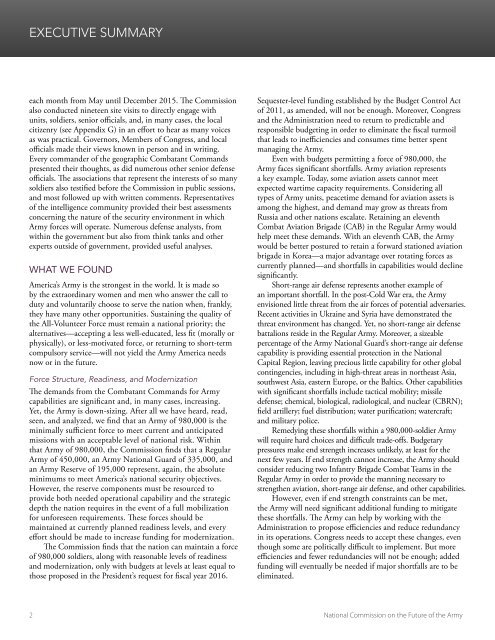THE FUTURE OF THE ARMY
1PlAz6L
1PlAz6L
Create successful ePaper yourself
Turn your PDF publications into a flip-book with our unique Google optimized e-Paper software.
EXECUTIVE SUMMARY<br />
each month from May until December 2015. The Commission<br />
also conducted nineteen site visits to directly engage with<br />
units, soldiers, senior officials, and, in many cases, the local<br />
citizenry (see Appendix G) in an effort to hear as many voices<br />
as was practical. Governors, Members of Congress, and local<br />
officials made their views known in person and in writing.<br />
Every commander of the geographic Combatant Commands<br />
presented their thoughts, as did numerous other senior defense<br />
officials. The associations that represent the interests of so many<br />
soldiers also testified before the Commission in public sessions,<br />
and most followed up with written comments. Representatives<br />
of the intelligence community provided their best assessments<br />
concerning the nature of the security environment in which<br />
Army forces will operate. Numerous defense analysts, from<br />
within the government but also from think tanks and other<br />
experts outside of government, provided useful analyses.<br />
WHAT WE FOUND<br />
America’s Army is the strongest in the world. It is made so<br />
by the extraordinary women and men who answer the call to<br />
duty and voluntarily choose to serve the nation when, frankly,<br />
they have many other opportunities. Sustaining the quality of<br />
the All-Volunteer Force must remain a national priority; the<br />
alternatives—accepting a less well-educated, less fit (morally or<br />
physically), or less-motivated force, or returning to short-term<br />
compulsory service—will not yield the Army America needs<br />
now or in the future.<br />
Force Structure, Readiness, and Modernization<br />
The demands from the Combatant Commands for Army<br />
capabilities are significant and, in many cases, increasing.<br />
Yet, the Army is down-sizing. After all we have heard, read,<br />
seen, and analyzed, we find that an Army of 980,000 is the<br />
minimally sufficient force to meet current and anticipated<br />
missions with an acceptable level of national risk. Within<br />
that Army of 980,000, the Commission finds that a Regular<br />
Army of 450,000, an Army National Guard of 335,000, and<br />
an Army Reserve of 195,000 represent, again, the absolute<br />
minimums to meet America’s national security objectives.<br />
However, the reserve components must be resourced to<br />
provide both needed operational capability and the strategic<br />
depth the nation requires in the event of a full mobilization<br />
for unforeseen requirements. These forces should be<br />
maintained at currently planned readiness levels, and every<br />
effort should be made to increase funding for modernization.<br />
The Commission finds that the nation can maintain a force<br />
of 980,000 soldiers, along with reasonable levels of readiness<br />
and modernization, only with budgets at levels at least equal to<br />
those proposed in the President’s request for fiscal year 2016.<br />
Sequester-level funding established by the Budget Control Act<br />
of 2011, as amended, will not be enough. Moreover, Congress<br />
and the Administration need to return to predictable and<br />
responsible budgeting in order to eliminate the fiscal turmoil<br />
that leads to inefficiencies and consumes time better spent<br />
managing the Army.<br />
Even with budgets permitting a force of 980,000, the<br />
Army faces significant shortfalls. Army aviation represents<br />
a key example. Today, some aviation assets cannot meet<br />
expected wartime capacity requirements. Considering all<br />
types of Army units, peacetime demand for aviation assets is<br />
among the highest, and demand may grow as threats from<br />
Russia and other nations escalate. Retaining an eleventh<br />
Combat Aviation Brigade (CAB) in the Regular Army would<br />
help meet these demands. With an eleventh CAB, the Army<br />
would be better postured to retain a forward stationed aviation<br />
brigade in Korea—a major advantage over rotating forces as<br />
currently planned—and shortfalls in capabilities would decline<br />
significantly.<br />
Short-range air defense represents another example of<br />
an important shortfall. In the post-Cold War era, the Army<br />
envisioned little threat from the air forces of potential adversaries.<br />
Recent activities in Ukraine and Syria have demonstrated the<br />
threat environment has changed. Yet, no short-range air defense<br />
battalions reside in the Regular Army. Moreover, a sizeable<br />
percentage of the Army National Guard’s short-range air defense<br />
capability is providing essential protection in the National<br />
Capital Region, leaving precious little capability for other global<br />
contingencies, including in high-threat areas in northeast Asia,<br />
southwest Asia, eastern Europe, or the Baltics. Other capabilities<br />
with significant shortfalls include tactical mobility; missile<br />
defense; chemical, biological, radiological, and nuclear (CBRN);<br />
field artillery; fuel distribution; water purification; watercraft;<br />
and military police.<br />
Remedying these shortfalls within a 980,000-soldier Army<br />
will require hard choices and difficult trade-offs. Budgetary<br />
pressures make end strength increases unlikely, at least for the<br />
next few years. If end strength cannot increase, the Army should<br />
consider reducing two Infantry Brigade Combat Teams in the<br />
Regular Army in order to provide the manning necessary to<br />
strengthen aviation, short-range air defense, and other capabilities.<br />
However, even if end strength constraints can be met,<br />
the Army will need significant additional funding to mitigate<br />
these shortfalls. The Army can help by working with the<br />
Administration to propose efficiencies and reduce redundancy<br />
in its operations. Congress needs to accept these changes, even<br />
though some are politically difficult to implement. But more<br />
efficiencies and fewer redundancies will not be enough; added<br />
funding will eventually be needed if major shortfalls are to be<br />
eliminated.<br />
2 National Commission on the Future of the Army


